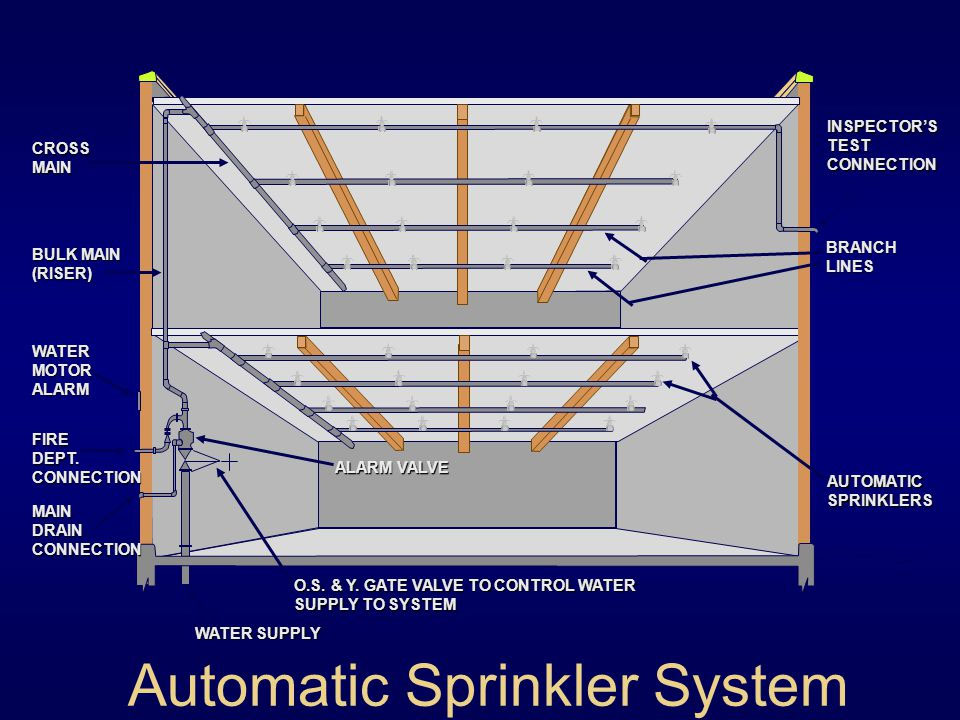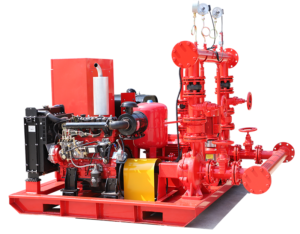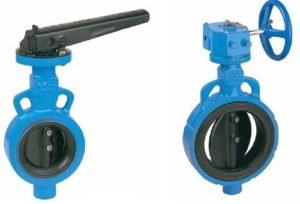A fire sprinkler system is an active fire protection method, consisting of a water supply system, providing adequate pressure and flowrate to a water distribution piping system, onto which fire sprinkler heads are connected

Fire Pumpset
A pumpset usually consisting One-Duty-One-Standby, Jockey and Pressure Tank that is used to provide water at adequate pressure to meet the hydraulic design requirements of the system. They are commonly used on standpipe and sprinkler systems in high rise buildings, as well as for warehouses that contain high hazard storage.

Jockey Pump
Small pump, used in conjunction with a fire pump that is connected to the sprinkler system. It is used to make up small pressure fluctuations in the system.

OS&Y Gate Valve
A common type of control valve used to regulate flow in a system. When the stem rises, the gate in the valve lifts, and water can flow through the valve.
Post Indicator Valve (PIV)
A valve that controls the water that is flowing into the building in the event of a fire. It also provides a visual indication if a gate valve is open or closed.

Alarm Check Valve
A common type of fire sprinkler system alarm apparatus. When water flows in an alarm valve, the valve’s clapper will lift off of the seat, and water will flow through the alarm line. The alarm line will be connected to either a mechanical water motor gong, or an electric bell. When water flows through the line, either the gong or electric bell will ring, which alert passer-byers to contact emergency services.

Butterfly Valve
A common type of control valve used to regulate flow in a system. It is an indicating type, since you can see whether it’s open or closed by looking at the orientation of the “flag” on the valve.
Check Valve
A valve that allows in only one direction to prevent backflow. For example, this device is used to prevent water in the fire sprinkler system from returning to the public water supply.
Control Valve
This is usually Controls the flow of water to the sprinkler system. In other words, closing this valve will prevent water from flowing out of the fire sprinklers.

Fire Sprinkler Head
In general, a device that, in the event of a fire, will open automatically, and discharge water. The sprinkler head opens automatically when the activating link (either a glass bulk or pieces of soldered metal) reaches a certain temperature. When the link disengages, the orifice cap is released, and water will flow out of the sprinkler head. There are many different types of sprinkler heads, including quick response, standard response, extended coverage, extended coverage fast response, and open sprinklers. They can be installed in either the upright, pendent, or sidewall orientations.

Hangers
Component that holds the sprinkler pipe in the air. The hanger itself needs to be attached to the building structure (i.e. joists, beams, concrete slab) with parts known as inserts, flanges, and clamps
Inspectors Test
A device used to test the alarm that must activate when water flows through the sprinkler system.
Main Drain
Primary drain connection located on the riser. This drain allows you to empty the water out of the system. It is also used to determine the static and residual pressures of the building’s water supply.
Retard Chamber
A device used to reduce the possibility of false alarms due to changes in the water supply pressure (i.e. water surges).
Sprinkler or suppression projects can have a lot of variables. You want cutting edge solutions, thoughtfully applied to your needs. Our in-depth industry knowledge and integrated approach provides a solution that’s just right for you. No sprinkler or suppression project is too large or too small, too easy or too complex. Whether you need a conventional or Special Hazards system, we’re on the cutting edge of solutions. We have access to an extraordinary depth of products, including global-leading TYCO, RELIABLE, and VIKING, SHIELD UK brands.
If you’re looking for a code-compliant and cost-effective sprinkler solution for your application, we’d like to help. We can tailor a solution that fits your needs, no matter your size, complexity or line of business. From new installation to retrofit, freestanding or integrated, we will configure your system specifically for its environment — with thought given to ease of expansion or future upgrade.
No matter where your facility is located, or how many facilities you have, Shiramafiretex will deliver high-quality, cost-effective solutions you expect.
For a Sprinkler system that inspires confidence, go with Shiramafiretex. You benefit from our integrated approach and flexible, scalable systems that can grow as your needs change
Shiramafiretex will
- Help ensure you have the right number and types of fire extinguishers to meet code requirements, or supplement other existing fire protection solution, all backed up by the best service and maintenance plan for you.
- Not just inspect your fire extinguishers, we also inspect the hazards they cover, using bar coding to make sure the right extinguishers stay in the right places.
- Track the lifecycle of your extinguishers, so you can rest assured they are always recharged, inspected and replaced when needed.